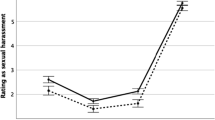Abstract
The purpose of this study was to investigate the effect of cosmetics use on attributions concerning the likelihood of provoking sexual harassment and of being sexually harassed. Subjects were 85 female and 76 male undergraduate volunteers. The study was a 3×2 between-subjects design with three levels of cosmetics use (heavy, moderate, no cosmetics) and two levels of sex of subject (male, female). Each subject viewed one of three colored photographs of a model wearing either heavy, moderate, or no cosmetics, and then indicated how likely the model was to provoke sexual harassment and to be sexually harassed. Data were analyzed using analyses of variance and the Newman-Keuls test. When the model wore heavy cosmetics, she was rated as more likely to provoke sexual harassment than when she wore moderate cosmetics. Similarly, when the model wore moderate cosmetics, she was rated as significantly more likely to provoke sexual harassment than when she was not wearing cosmetics. When the model wore either heavy or moderate cosmetics, she was also rated as more likely to be sexually harassed than when she did not wear cosmetics. In addition, male subjects rated the model as more likely to provoke and to be sexually harassed than did female subjects. Results are discussed in terms of sex role spillover.
Similar content being viewed by others
References
Abbey, A., Cozzarelli, C., McLaughlin, K., & Harnish, R. (1987). The effects of clothing and sex dyad composition on perceptions of sexual intent: Do women and men evaluate these cues differently? Journal of Applied Social Psychology, 17, 108–126.
Allgeier, E., & McCormick, N. (1983). Changing boundaries: Gender roles and sexual behavior. Palo Alto, CA: Mayfield.
Banner, L. (1983). American beauty. New York: Alfred A. Knopf.
Cash, T., & Cash, D. (1982). Women's use of cosmetics: Psychosocial correlates and consequences. International Journal of Cosmetic Science, 4, 1–14.
Cash, T., Rissi, J., & Chapman, R. (1985). Not just another pretty face: Sex roles, locus of control and cosmetics use. Personality and Social Psychology Bulletin, 11, 246–257.
Cash, T., Dawson, K., Davis, P., Bowen, M., & Galumbeck, C. (1989). Effects of cosmetics use on the physical attractiveness and body image of American college women. The Journal of Social Psychology, 129, 349–355.
Cox, C., & Glick, W. (1986). Resume evaluations and cosmetics use: When more is not better. Sex Roles, 14, 51–58.
Dion, K., Berscheid, E., & Walster, E. (1972). What is beautiful is good. Journal of Personality and Social Psychology, 24, 285–290.
Farley, L. (1978). Sexual shakedown: The sexual harassment of women on the job. New York: McGraw-Hill.
Fine, J. (1987, August 24–30). No laughing matter: Sexual harassment is serious problem for companies. Dallas Times Herald, pp. 9–11.
Graham, J., & Jouhar, A. (1981). The effects of cosmetics on person perception. International Journal of Cosmetic Science, 3, 199–208.
Gutek, B., & Morasch, B. (1982). Sex-ratios, sex-role spillover, and sexual harassment of women at work. Journal of Social Issues, 38, 55–74.
Horgan, D., & Reeder, G. (1986). Sexual harassment: The eye of the beholder. Journal of the American Association of Occupational Health Nurses, 34, 83–86.
Jensen, I., & Gutek, B. (1982). Attributions and and assignment of responsibility in sexual harassment. Journal of Social Issues, 38, 121–136.
Johnson, K., & Lewis, L. (1988). Effect of dress, cosmetics, and sex of subject on impressions of victim personality. Texas Home Economist, 55, 6–7.
Lerner, R., Karabenick, S., & Stuart, J. (1973). Relations among physical attractiveness, body attitudes, and self-concept in male and female college students. Journal of Psychology, 85, 119–129.
McCall, G., & Simmons, J. (1978). Identities and interactions. New York: Free Press-Macmillan.
McKeachie, W. (1952). Lipstick as a determiner of first impressions of personality: An experiment for the general psychology course. Journal of Social Psychology, 36, 241–244.
Miller, A. (1970a). Role of physical attractiveness in impression formation. Psychonomic Science, 19, 241–243.
Miller, A. (1970b). Social perception of internal-external control. Perceptual and Motor Skills, 30, 103–109.
Naugarten, D., & Shafritz, J. (1980). Sexuality in organizations: Romantic and coercive behaviors at work. Oak Park, IL: Moore.
Nivea, V., & Gutek, B. (1981). Women and work: A psychological perspective. New York: Praeger.
Roach, M., & Eicher, J. (1979). The language of personal adornment. In J. M. Cordwell & R. A. Schwarz (Eds.), The fabric of culture: The anthropology of dress and adorment. Mouton: The Hague.
Supreme Court upholds EEOC position on sex harassment. (1986, August). Equal Times. U.S. Equal Employment Opportunity Commission.
Vogelmann-Sine, S., Ervin, E., Christensen, R., Warmsun, C., & Ullman, L. (1979). Sex differences in feelings attributed to a woman in situations involving coercion and sexual advances. Journal of Personality, 47, 420–431.
Wilson, E. (1987). Adorned in dreams. Los Angeles: University of California Press.
Workman, J., & Johnson, K. (in press). The role of cosmetics in impression formation. Clothing and Textiles Research Journal.
Zellman, G., & Goodchilds, J. (1983). Becoming sexual in adolescence. In E. A. Allgeier & N. B. McCormick (Eds.), Changing boundaries: Gender roles and sexual behavior. Palo Alto, CA: Mayfield.
Author information
Authors and Affiliations
Additional information
This study was part of a larger research project concerned with cosmetics and social interaction. For another part of the study, see Workman and Johnson (in press).
Rights and permissions
About this article
Cite this article
Workman, J.E., Johnson, K.K.P. The role of cosmetics in attributions about sexual harassment. Sex Roles 24, 759–769 (1991). https://doi.org/10.1007/BF00288211
Issue Date:
DOI: https://doi.org/10.1007/BF00288211




